Nicole Faghin, Coastal Management Specialist
Kevin Decker, Coastal Economist
Nicole Faghin, Coastal Management Specialist
Nicole Faghin, Coastal Management Specialist, Ian Miller, Coastal Hazards Specialist and Sue Blake, Water Resource Educator
Kevin Decker, Coastal Economist
Preparing our communities for resilience along the coastline of Washington is a top priority of Washington Sea Grant. As the culminating product of the 3-year Washington Coastal Resilience Project (WCRP), WSG partnered with Washington Department of Ecology to create a new website for the Coastal Hazards Resilience Network (CHRN) that included a site-specific interactive “Risk Reduction Project Mapper.” The mapper offers users a way to learn about coastal hazards science, with the hopes that, through education and understanding, coastal disasters might be reduced.
Washington’s coastlines hold a plethora of economic, environmental, social, and cultural heritage benefits for our state and Tribal Nations. The state’s coastal areas are also heavily populated, thus making them vulnerable to natural hazards such as flooding, landslides and earthquakes. Climate change and rising sea levels will only compound the frequency and severity of these hazards, and far-sighted community planning and project design will be vital in facing these impacts effectively.
Another key product of the WCRP project was the sea level rise data visualizations created by WSG and the WCRP team, which produced updated probabilistic sea level rise projections for the entire coastline of Washington State. University of Washington Climate Impacts Group created a tool to visualize the projections, together the WCRP provided planners and jurisdictions with critical new tools for coastal resilience planning.
March 3, 2025
By Maddie Gard, WSG Science Communications Fellow
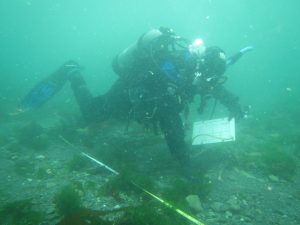
Elwha River dam removal SCUBA marine ecosystem monitoring – Photo courtesy of Ian Miller
When the Elwha River dams were breached in 2011, a century’s worth of accumulated sediment was released and transported downstream to the coastal zone. An estimated 19 million metric tons of mud, sand and gravel that had been trapped in the dam reservoirs transformed twists and turns of the Elwha River, eventually flushing out to the coast and reshaping the river delta near Port Angeles. Since then, Washington Sea Grant (WSG) coastal hazards specialist Ian Miller has been investigating and assessing the coastal influences of the Elwha watershed restoration and resulting sediment transport.
Miller has been closely connected to the Elwha River long before the dam removals occurred. Early in his career he worked on the Olympic Peninsula as an environmental educator, where he taught students about the Elwha dam removals as a case study in discussions about environmental decision-making. In graduate school, his PhD dissertation centered around Elwha River sediment transport and shoreline evolution modeling. Upon graduation, he joined the WSG team as a coastal hazards specialist, around the same time the Elwha dam removal decision was made.
The timing was uncanny, and Miller saw the opportunity to develop a high frequency monitoring program to determine how the shoreline and river delta would respond physically when the dams were breached. Ultimately, the coastline near the Elwha River’s mouth transformed. Huge amounts of sediment built new stretches of sandy beach and sandbars peeking above the water’s surface. Brackish lagoons formed where freshwater pooled in between swirling sandbars. Prior to the removals, researchers had developed theories about what might happen, but now they could monitor how the nourishment of sediments to the river delta impacted shorelines in real time.
Where sediments would end up, how long they would last, and the impact increased sediments would have in terms of changing shoreline conditions were top priority questions for the coastal hazards specialist. During this time, a SCUBA-based marine ecosystem monitoring project was developed by the United States Geological Survey to determine how the marine community responded to changing coastal conditions. In his position at WSG, Miller served as a local liaison for researchers visiting the Port Angeles area, helping to connect resources, support research objectives, and build the network of professionals interested in the Elwha River. WSG-funded monitoring efforts confirmed that sediments reshaped the shoreline and restored eroding beaches.
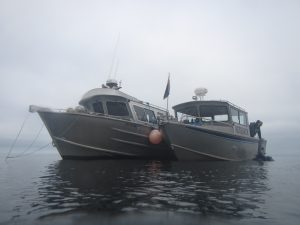
Research vessels conducting observations for Elwha River marine-community and sediment transport monitoring – Photo courtesy of Ian Miller
Prior to the Elwha River dam removals, many scientists were concerned that the sediments released would be catastrophic for the marine community. Years later, we know the dam removal and its cascading ecological effects have shifted some compositions of invertebrate species, including insects and crabs in the river delta. Kelp have mostly recovered, and the marine community as a whole near the river delta has been resilient to impacts. With this in mind, other rivers and coastal river delta systems may respond differently to dam removals. Every river and coastal system is different in its geomorphology, and varying changes to land-use such can have very different results in other systems.
Sediment changes in the Elwha continue to be relevant to Miller’s role with WSG. He works with coastal communities and public agencies in Washington state to strengthen their ability to plan for and manage coastal hazards, including chronic erosion, coastal flooding, and sea level rise associated with climate change. As it happens, nourishment from sediments is a coastal management strategy already being used for climate adaptations. Many coastal communities use beach nourishment, or the intentional pumping and placing of sand on shorelines, as a method for dealing with hazards exacerbated by sea-level rise. Sediment nourishment can also occur naturally through landslides, volcanoes, and erosion processes. From a coastal management standpoint, the Elwha River has been a unique opportunity to study how deposited sediments provide natural nourishment to a river delta and shoreline, informing how and when this strategy could be applied elsewhere.
The Elwha River’s storyline is still unfolding. While it is unclear whether the marine community-focused SCUBA monitoring will continue this summer, Miller will continue his shoreline survey monitoring of sediments and their transport with Dr. Christie Hegermiller and student researchers, Cal Schurman and Sam Alampay. His career has been closely intertwined with the river since long before the dam removals occurred, and he’ll continue to keep his eyes on the Elwha going forward.
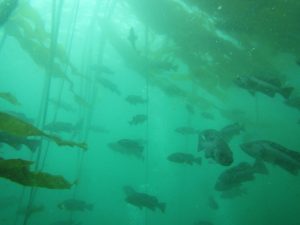
Bull kelp and rockfish in the Elwha drift cell, more than a decade after the Elwha River dam removals – Photo courtesy of Ian Miller
###
Washington Sea Grant, based at the University of Washington, helps people and marine life thrive through research, technical expertise and education supporting the responsible use and conservation of coastal ecosystems. Washington Sea Grant is one of 34 Sea Grant programs supported by the National Oceanic and Atmospheric Administration in coastal and Great Lakes states that encourage the wise stewardship of our marine resources through research, education, outreach and technology transfer.
Join the conversation: instagram.com/waseagrant and Facebook.com/WaSeaGrant.
January 23, 2025
By Maddie Gard, WSG Science Communications Fellow
A decade ago, the northern shore of Willapa Bay was washing away — along with the homes and businesses of the North Cove community. Rapid coastal erosion along North Cove beach in Pacific County, Washington was causing over 100 feet of beach to disappear annually into the ocean on average. Willapa Bay experiences large tides, offshore waves, nearshore currents, and strong seasonal storm surges that combine to transport millions of cubic yards of sediment on the sandy coastline. Cape Shoalwater was the fastest eroding landscape on the West Coast at the time, with approximately 640 of North Cove’s original 766 land parcels already lost to the waves. Without intervention, culturally and historically significant lands to the Shoalwater Bay Indian Tribe, 800 acres of local cranberry farms, and key sections of State Route 105 were at stake for erosion or flooding.
The community needed someone to advocate for the economic value of the land in order to boost their requests for restoration support, and Kevin Decker, Washington Sea Grant (WSG) coastal economist, answered the call. Thanks to this collective work, in 2024 the American Shore and Beach Preservation Association selected North Cove beach as one of the nation’s Best Restored Beaches.
Seeking to mitigate ongoing shoreline erosion and protect the remaining North Cove community, Willapa Erosion Control Action Now (WECAN) was formed in 2015. This ongoing initiative was assembled by North Cove community leaders such as Chairwoman Charlene Nelson of the Shoalwater Bay Tribe, Pacific County Commissioner Lisa Ayers, and David Cottrell, the commissioner of Pacific County Drainage District No. 1, to coordinate activism targeting the erosion issue.
To save North Cove and restore the beach, WECAN needed funding and resources. Kevin Decker, WSG coastal economist, became involved in the restoration initiatives by the community’s request. Funding for restoration projects are often prioritized based on net benefits. Yet, at the time, no one was considering the economic value of the community homes and properties being swept away.
By reporting the historic and projected economic losses of properties lost to shoreline erosion, Kevin illustrated the financial incentives for funding organizations to support North Cove’s restoration and coastal resilience efforts. In his economic analysis, Kevin found that if no action was taken to stabilize the shoreline, approximately 280 more residential properties and $30 million in property value would be lost by 2060.
“There was already a lot of energy and effort catalyzed by the North Cove community and Shoalwater Bay Tribe. My analysis provided the justification that was needed to take action …and the community did a great job of promoting it,” Decker says.
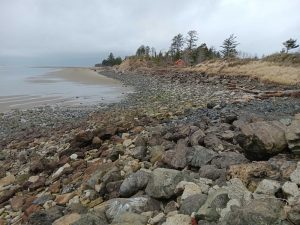
Photo courtesy of MyCoast Washington’s North Cove Seamobile Project
Decker’s report, The Economic Toll of a Disappearing Community, has been included by WECAN in several funding requests to support investing in solutions to the shoreline erosion. The report caught the attention of the National Oceanic Atmospheric Administration (NOAA), the United States Army Corps of Engineers, and Pacific Conservation District, and restoration projects began later the same year Decker’s report was published.
The North Cove community created cobblestone berms along the beach by strategically placing 46,500 cubic yards of cobbles, gravel and pebbles. They planted native vegetation and designed wood structures to create a natural and dynamically stable beach that shields from wave energy and retains sand. Today, the stretch of shoreline is a healthy recreational beach enjoyed by both the public and wildlife species of interest.
“With beach stabilization, the North Cove community can begin to look toward the future instead of worrying about whether their community will exist tomorrow,” Decker says. “Stability means people will start investing in their community, improving their homes, building wealth through home equity, and passing homes on to their families. It means a positive economic outlook for North Cove.” If North Cove’s nature-based approach is maintained overtime, the natural berms and sand dunes will adjust to waves and water levels, providing the community with long term coastal resilience to climate change and sea level rise.
###
Washington Sea Grant, based at the University of Washington, helps people and marine life thrive through research, technical expertise and education supporting the responsible use and conservation of coastal ecosystems. Washington Sea Grant is one of 34 Sea Grant programs supported by the National Oceanic and Atmospheric Administration in coastal and Great Lakes states that encourage the wise stewardship of our marine resources through research, education, outreach and technology transfer.
Join the conversation: instagram.com/waseagrant and Facebook.com/WaSeaGrant.
Bridget Trosin, Coastal Policy Specialist
Ecosystems, infrastructure and people will be impacted by the phenomenon of climate change and rising sea levels. The King Tides Program and community events inform coastal dwellers about twice-yearly extreme tides. Citizens’ photos of king tides are posted on the website.The website helps local communities and decision makers visualize the challenges we will face as the climate changes.
More information:
February 27, 2024
From rising seas to eroding shorelines and more frequent, intense storms, the hazards faced by coastal communities are only projected to grow. Recognizing these threats, planners and managers around Washington are assessing the vulnerability of their communities and planning for impacts – in particular, the impacts of coastal flooding due to storms, sea level rise, and river flooding. But planning for coastal flooding can be difficult when so many different, compounding factors affect where water flows and how high it gets.
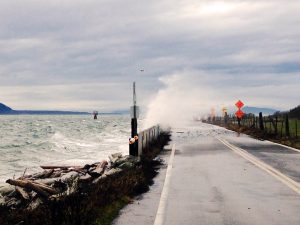
Courtesy of Washington Sea Grant. Photo by Pete Granger.
The Coastal Storm Modeling System (CoSMoS), now expanded to include Puget Sound, is one tool that can help. CoSMoS is a numerical modeling system uniquely capable of interpreting the physics of compound flooding – coastal storms, sea level rise, and river flooding – down to the local scale. As a result, planners, managers and residents can use the new system to help them understand the impacts of coastal flooding to county property, homes and businesses. Whatcom County is the first in Washington state to receive specific projections and results from the tool. And while Whatcom County results were published first, location-specific CoSMoS data will soon be available statewide.
Puget Sound comprises 2,600 miles of coastline – home to diverse communities, important infrastructure and industry, and habitat critical for commercial fisheries, Tribal Treaty Rights and public well-being. Much of this coastline is at risk of flooding due to the combination of sea level rise, storms, tides and overflowing rivers. Yet whether it lies within a river floodplain or holds important municipal infrastructure, each piece of shoreline has unique and valuable traits that flooding can impact in different ways. CoSMoS has several key features that make it especially useful for examining potential impacts to Puget Sound. First, the system incorporates wind, atmospheric pressure, and sea surface temperature data from global climate models. It then combines these data with models of local water levels that include factors like tides and storm surge. Finally, CoSMoS incorporates a wide range of sea level rise scenarios, allowing planners to view potential flooding impacts in both the near and long term.
“The model couples together a lot of different coastal impacts. It’s not just sea level rise data, just wave data, just storm data – it’s all of those things together, and all of those things can be factors in the flooding that people experience,” says Sydney Fishman, coastal management specialist at Washington Sea Grant. “The fact that CoSMoS can model all of these factors, that makes it especially important for our geography.”
Predicting local flooding impacts with this level of precision has many uses, especially to local planners. Whatcom County already experiences periodic flooding and storm damage, in particular on the coast and around the lower Nooksack River. The county is actively planning for future higher water levels, more intense storms, and the flooding they bring. Data such as those from the CoSMoS project help planners determine which assets – from roads to ports and parks – are most at risk, and which are most in need of protection. CoSMoS has even been combined with other information to show local socioeconomic impacts from different flooding events. With information in hand, planners can begin to determine which mitigation and adaptation strategies will work best to protect their particular communities.
Plugging the data now available for Whatcom County into USGS’s Hazard Exposure Reporting and Analytics (HERA) web tool allows a user to define a flooding scenario and see the impacts on particular assets in the county. For example, a user can see how many miles of road would likely be flooded in a scenario of 1.6 feet of sea level rise plus a 100-year coastal storm (defined as a storm with 1% chance of occurring in any given year). The user could even specify roads by type, such as highways, surface streets, or secondary streets.
“CoSMoS has been an invaluable resource,” notes Chris Elder, Senior Watershed Planner at Whatcom County. “It provides local governments like Whatcom County with the ability to not only have a better understanding of storm surge extent and depth, but also to understand inundation and storm surge impacts under projected future sea levels. Access to this data has allowed Whatcom County and partner agencies and governments to assess vulnerability along our marine shorelines and to inform development of necessary adaptation actions.”
Products are available to view in the USGS HERA web tool (usgs.gov/apps/hera) and for download of geospatial hazard data go to:
Grossman, E.E., vanArendonk, N.R., Crosby, S.C., Tehranirad, B., Nederhoff, K., Parker, K.A., Barnard, P.L., Erikson, L.H., Danielson, J.J. 2024. Coastal hazards assessment associated with sea level rise and storms along the Whatcom County, Northwest Washington State coast, U.S. Geological Survey data release, https://doi.org/10.5066/P9I08NS5.
More information is available at the Washington Coastal Hazards Resilience Network: https://wacoastalnetwork.com/project-support/mappers-and-visualizations/cosmos/
Media Contacts:
Chandler Countryman, resilience and adaptation specialist, Washington Sea Grant: ccount@uw.edu; T 206.543.7347
Sydney Fishman, coastal management specialist, Washington Sea Grant: sfishma@uw.edu; T 206.543.5051
###
Washington Sea Grant, based at the University of Washington, helps people and marine life thrive through research, technical expertise and education supporting the responsible use and conservation of coastal ecosystems. The National Sea Grant College Program is part of the National Oceanic and Atmospheric Administration, U.S. Department of Commerce.
Join the conversation: instagram.com/waseagrant and Facebook.com/WaSeaGrant.
August 14, 2024
Washington Sea Grant (WSG) co-led with University of Washington’s Climate Impacts Group and the Affiliated Tribes of Northwest Indians a new report sharing Northwest coastal tribes’ needs and barriers as they work to adapt to climate change. The report compiles findings from six Tribal listening sessions where Tribal members were invited to share their experiences around climate change adaptation in their communities.
The report, “Climate adaptation barriers and needs experienced by Northwest coastal Tribes: Key findings from Tribal listening sessions,” is freely available online.
Related: “Pacific Northwest tribes are battered by climate change but fight to get money meant to help them” – The Associated Press
###
Washington Sea Grant, based at the University of Washington, helps people and marine life thrive through research, technical expertise and education supporting the responsible use and conservation of coastal ecosystems. The National Sea Grant College Program is part of the National Oceanic and Atmospheric Administration, U.S. Department of Commerce.
Join the conversation: instagram.com/waseagrant and Facebook.com/WaSeaGrant.
February 15, 2024
By Chandler Countryman, Washington Sea Grant Resilience and Adaptation Specialist
Last week, Washington Sea Grant took part in the Shoalwater Bay Indian Tribe Partnership Gathering presented by the Office of Secretary, U.S. Department of Transportation, Thriving Communities and Main Street America.
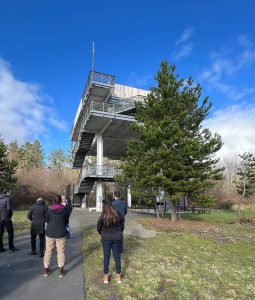
The Shoalwater Bay Indian Tribe’s Tsunami Vertical Evacuation Tower
More than 50 participants gathered in Tokeland, Washington to gain a deeper understanding of the Shoalwater Bay Indian Tribe’s upland relocation efforts. The Tribe has done a tremendous amount of work since 2009 to relocate their community away from the low-lying coastal shores (a location that the Tribe is deeply connected to and has historically called home) due to ongoing challenges related to coastal hazards, especially intense coastal erosion and coastal storms. The area is losing 100-124 feet of land per year – the fastest rate of erosion on the West Coast, and a rate that has already led to the loss of many locally important assets including but not limited to more than 50 homes, a cemetery, a lighthouse, a clam cannery, and about 2 miles of land. It is estimated that with 2 feet of sea level rise – the amount the National Oceanic and Atmospheric Administration projects to happen by the end of this century – Tokeland will be entirely underwater. Unsurprisingly, one of the major beaches in the area is called Washaway Beach.
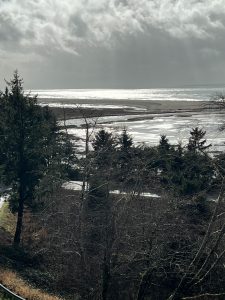
Views of the Pacific Ocean from the Shoalwater Bay Indian Tribe’s Evacuation Multipurpose Building
The relocation and expansion of the Tribe’s community up the hill and out of harm’s way is a massive undertaking that requires the participation of many federal, state, and local partners to work alongside the Tribe to get it done. These partners came together last week to hear from the Tribe about their various climate resilience efforts, identify gaps in support around their upland expansion project, and map out how partners can best assist the Tribe as they move forward with this work. Partners hopped in vans and on ATVs to tour the upland expansion area, the Tsunami Vertical Evacuation Tower, housing development sites, an evacuation multipurpose building, oyster operations, the tribal museum, and the Army Corps of Engineers berm that is currently protecting much of the shoreline. These were wonderful examples of ways that the Shoalwater Bay Indian Tribe has adapted to change throughout time, reflecting their incredible ability to endure and highlighting their aptitude for resilience.
Over this three day gathering, the Tribe and partners shared many delicious meals together and even more valuable conversations around current and future collaborations, resulting in partnership mapping and action-oriented planning. This event was incredibly special as it is rare to have so many partnering entities at the table simultaneously. We were so happy and grateful to be a part of these conversations and to have been invited by the Shoalwater Bay Indian Tribe.
###
Washington Sea Grant, based at the University of Washington, helps people and marine life thrive through research, technical expertise and education supporting the responsible use and conservation of coastal ecosystems. The National Sea Grant College Program is part of the National Oceanic and Atmospheric Administration, U.S. Department of Commerce.
Join the conversation: instagram.com/waseagrant and Facebook.com/WaSeaGrant.
Nicole Faghin, Coastal Management Specialist
With climate change comes impacts to our coastlines from storm surges and rising sea levels. Planning for climate change is an important priority for Washington’s coastal communities. For professionals planning ahead to address sea level rise, WSG specialists offer a course through the Coastal Training Program.
Course materials include adaptation tools and methods, flood impact and risk-reduction planning, climate-change and sea-level-rise communication strategies and inundation mapping strategies. Courses are taught in conjunction with NOAA’s Office of Coastal Management.
Contact Nicole Faghin at faghin@uw.edu.
Melissa Poe, Social Scientist
Key initiatives include surveys, focus groups and participatory risk assessments with several Washington communities whose wellbeing is tied to marine resources. Information about social and cultural variables such as food security, cultural practices, livelihoods and a community’s sense of place help to identify anticipated and cumulative threats.
Carrie Garrison-Laney, Coastal Hazards Specialist
Ian Miller, Coastal Hazards Specialist
WSG has teamed with state and federal agencies working at the forefront of tsunami research and outreach to help prepare Washington coastal communities for the next tsunami. Washington is vulnerable to tsunamis from both local and distant earthquakes, and there is geologic evidence for past tsunamis in many Washington locations. Because of this, tsunami hazard awareness and planning is a number one priority for community resiliency. WSG’s coastal hazard experts Ian Miller and Carrie Garrison-Laney collaborate with state and county emergency managers and maritime groups around the state and give public presentations focused on education and preparation.
January 10, 2024
Washington Sea Grant (WSG) is pleased to receive federal funds through NOAA Sea Grant in support of its work to advance resilience in coastal and fishing communities throughout Washington state.
The WSG project seeks to enhance Washington coastal resilience in several ways. These include but are not limited to: broadening outreach to coastal communities on coast-specific climate hazards; connecting marine and coastal resource managers with funding opportunities to address coastal hazards; communicating hazard risk reduction and resilience best practices to coastal stakeholders; and increasing capacity for shoreline erosion monitoring and analysis.
Coastal communities face a variety of challenges, from increased flooding and erosion to more intense storm surges and wind damage as a result of climate change and sea level rise. Recognizing these challenges, the project builds on WSG’s decadeslong efforts to deeply and sustainably engage and promote the resilience of Washington’s coast. Initiatives such as the WSG-led Washington Coastal Resilience Project have focused on increasing local access to sea level rise information and planning capacity, as well as capital investment in coastal restoration and infrastructure. WSG has also supported the ongoing development and rollout of the Coastal Storm Modeling System (CoSMoS) to help coastal planners and decision-makers understand their communities’ flood risks. These and similar efforts are all the more important given the threats posed by ocean and climate change are only projected to grow.
The WSG project also aims to promote resilience in Washington state fisheries. In particular, the project will leverage new funding to hire a new fisheries specialist, expanding staff capacity beyond Seattle and the Pacific Coast to northern Puget Sound. Other activities will include providing new trainings to help build a skilled fishing labor force; expanding or reviving trainings on sea safety and survival, first aid at sea, reading and responding to marine weather, and servicing and maintaining diesel engines; and continuing to support the direct marketing and sale of seafood from fishers to consumers. New funds will also help WSG support the Makah Tribe’s Food Sovereignty Program through increasing seafood access and distribution.
This project is made possible through NOAA Sea Grant Coastal Adaptation and Resilience institutional funding. NOAA Sea Grant awarded a total of $4 million to Sea Grant programs nationwide to further their work or act on new opportunities in the coastal resilience landscape.
Learn more about the other selected projects here.
###
Washington Sea Grant, based at the University of Washington, helps people and marine life thrive through research, technical expertise and education supporting the responsible use and conservation of coastal ecosystems. The National Sea Grant College Program is part of the National Oceanic and Atmospheric Administration, U.S. Department of Commerce.
Join the conversation: instagram.com/waseagrant and Facebook.com/WaSeaGrant.
February 12, 2024
Washington Sea Grant (WSG) is pleased to announce that it will partner with the Washington state departments of Ecology, Transportation, and Fish and Wildlife to support coastal resilience work as part of a new $850,000 grant. The grant comes from the National Coastal Resilience Fund, a partnership between the National Oceanic and Atmospheric Administration (NOAA) and the National Fish and Wildlife Foundation.
Washington’s 3,300 miles of shoreline along Puget Sound and the Pacific Ocean are home to coastal communities, public infrastructure, and important habitat. In the face of growing coastal hazards like sea level rise, flooding, and erosion, WSG will play a key role in supporting state efforts to protect critical infrastructure, improve community resilience, and advance nature-based solutions.
In particular, the funded project will allow the Washington state Department of Transportation (WSDOT) to update its 2011 climate impacts vulnerability assessment. WSG will provide technical expertise in incorporating new data and tools, including up-to-date local sea level rise projections, into this assessment.
WSG will also join the project team in working with local partners to identify three to six nature-based hazards resilience projects to implement at the community level. WSG will help to develop and implement community and stakeholder workshops toward this goal, as well as serve as a liaison between this project and other sea level rise and climate adaptation projects in Washington state.
This new funding builds on $74.4 million recently awarded by NOAA to the Washington state Department of Ecology for coastal and climate resilience work in Padilla and Willapa bays, as well as NOAA Sea Grant’s recent investments in WSG-led resilience work in coastal and fishing communities, part of $4 million distributed nationwide.
###
Washington Sea Grant, based at the University of Washington, helps people and marine life thrive through research, technical expertise and education supporting the responsible use and conservation of coastal ecosystems. The National Sea Grant College Program is part of the National Oceanic and Atmospheric Administration, U.S. Department of Commerce.
Join the conversation: instagram.com/waseagrant and Facebook.com/WaSeaGrant.